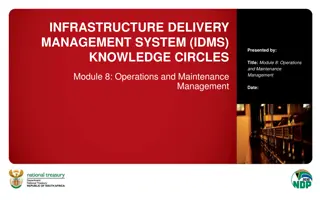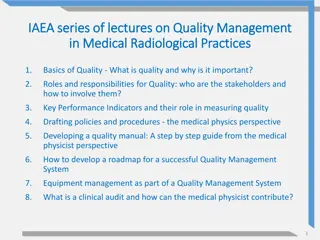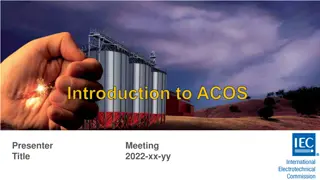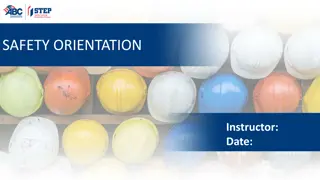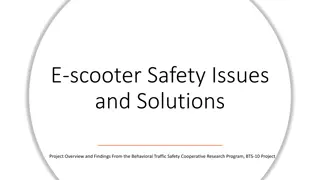Quality Management and Safety in Project Delivery
Quality management and safety are crucial aspects of project delivery, ensuring that projects meet or exceed client requirements. Quality encompasses factors such as longevity, needs fulfillment, cost-effectiveness, usability, security, and efficiency. Essential elements of quality include performance, usability, serviceability, portability, conformance, aesthetics, and durability. Quality assurance techniques play a vital role in ensuring the quality of project deliverables.
Download Presentation

Please find below an Image/Link to download the presentation.
The content on the website is provided AS IS for your information and personal use only. It may not be sold, licensed, or shared on other websites without obtaining consent from the author.If you encounter any issues during the download, it is possible that the publisher has removed the file from their server.
You are allowed to download the files provided on this website for personal or commercial use, subject to the condition that they are used lawfully. All files are the property of their respective owners.
The content on the website is provided AS IS for your information and personal use only. It may not be sold, licensed, or shared on other websites without obtaining consent from the author.
E N D
Presentation Transcript
WELCOME TO LECTURE 7 SELESTIAN AUGUSTINO
1. Use the two tables below to: (a) Draw the PERT network diagram (b) Calculate the expected time, variance and standard deviation of each activity (c) Draw the CPM network diagram (d) Calculate the project completion time (e) Find the critical path (f) Identify the critical activities.
2. Use the CPM diagram below to find the Critical Path, Earliest Start times, Earliest Finish times, Latest Start times, Latest Finish times and Total Floats of the critical path.
UNIT IV 4.1.0 Quality management and safety 4.1.1 Importance of quality What is quality? Quality can be defined as the the fulfillment of project responsibility in the delivery of projects and services in a manner that meets or exceeds the stated requirements and expectations of the owner/ client.
4.1.1 Importance of quality Quality ensures the following; Longevity How long the product performs its functions Needs fulfillment Whether or not the product fulfills a specific need or solves a specific problem for the client. Cost vs Need How much the product costs compared with how much the client wants or needs it. Usability The ease of use associated with the product.
Security The safety level of the product, meaning that, whether or not the client feels comfortable using it. Efficiency This is the product ability to save the client money, help the environment etc.
4.1.2 Elements (Dimensions) of quality Essential elements of quality includes the following; i. Performance ii. Usability iii. Serviceability iv. Portability v. Conformance vi. Aesthetics vii. Durability
4.1.3 Quality Assurance (QA) techniques Quality Assurance (QA) means the planned and systematic activities implemented in a quality system so that quality requirements and standards for a product / service is fulfilled. Techniques used in QA are; a) Inspection b) Benchmarking c) Cost-Benefit analysis d) Flow charting e) Statistical sampling f) Control charts g) Pareto diagram h) Histogram i) Testing
4.1.4 Importance of safety Safety management in construction is a systematic way of identifying hazards and managing risks relating to the construction works. Safety is the result of accepting risks positively. Accident in construction is the result of safety not ensured. Importance 1. To protect the public 2. To reduce work related accidents 3. To reduce time and money lost after an accident 4. To increase the compliance with a dedication to safety 5. Helps to know how to build a culture of safety on a construction site
4.1.5 Causes of accidents There are three major causes a) Individual or personal causes b) Circumstantial causes c) Mechanical and material causes a) Individual or personal causes For example; Carelessness, inexperience, loose clothes, unsafe practices, quick working, ignorance, loss of control by the operator of equipment, vehicle etc. b) Circumstantial causes For example; Too high or too low atmospheric temperature, poor lighting, poor ventilation, smoke, prolonged hours of work etc.
b) Mechanical and material causes For example; failure of temporary structures like scaffolds, shores, cofferdams, ladders etc, storing/handling/transporting explosives, contact of power transmission machinery with moving part of machine, slippery floors, slippery stairway, defective machines, tools etc. Effects of accidents are: 1. Loss of human lives 2. Loss or damage of material 3. Temporary or permanent injuries to workers 4. Loss or damage of equipment 5. Loss of time and production
4.1.6 Benefits of safety management Improved safety and health in the workplace Improved employee morale and job satisfaction Improved productivity Improved quality of work Improved competitiveness in the market place Reduced probability of accidents and errors Reduced absenteeism and employee turnover
4.1.7 Approaches to improve safety in construction Behavior modification Technological intervention Quality circle Personnel selection Exercise and stress management Reporting Near-miss accident Safety climate Zero injury technique
4.2.0 Construction disputes and their settlement 4.2.1 Introduction Dispute is a misunderstanding or disagreement (which may arise over many issues like money, property, employment, accidents, marriage breakups and family separations) between two or more parties. 4.2.2 Types/categories of industrial disputes i) Interest dispute Determination of new wage level and other condition of employment. Example employer and employee. ii) Right dispute It relate to interpretation and application of existing stand orders and usually involve an individual worker or group of workers.
Other types/categories of disputes includes: a) Dispute between consumer and retailer b) Dispute between families c) Dispute between neighbors d) Dispute about tenancy e) Dispute about accidents
4.2.3 Causes/development of disputes The common situations that lead to disputes in the construction fields are; Contract errors or omissions Differing site conditions Noncompliance of contractual obligations Failing to correctly administer the contract Claims errors
4.2.4 Settlement of disputes Some of the methods used for preventing and settling industrial disputes are: a) Collective bargaining b) Mediation c) Conciliation d) Arbitration e) Adjudication
a) Collective bargaining This is the process of negotiating terms of employment and other conditions of work between the representatives of management and organized labour. The representatives or spokesmen of management and labour must have a thorough knowledge on company s wage scale and the wage scales of the industry and the area. b) Mediation This is an attempt to settle disputes with the help of an outsider who attempts to stimulate labour and management to reach some type of agreement. The mediator cannot decide the issue. He listens, suggests, communicate and persuades. He doesn t give any awards.
c) Conciliation Conciliation is merely the bringing together by a third party the two parties in disputes. d) Arbitration This is the procedure in which a dispute is submitted, by agreement of the parties, to one or more arbitrators who make a binding decision on the dispute. In choosing arbitration, the parties opt for a private dispute resolution procedure instead of going to the court.
Self study Discuss in detail about adjudication
4.3.0 Construction Labour and Legislation 4.3.1.1 Labour and labour welfare Labour welfare means anything done for the comfort and improvement of intellectual and social to the employees over and above the wages paid. Labour welfare is an important dimension of industrial relation. It includes overall welfare facilities designed to take care of well being of employees in order to increase their living standard.
4.3.1.2 Objectives of labour welfare 1. It provides social comfort to employees. 2. It provides intellectual improvements of employees. 3. To build stable work force 4. To make employees live good and worth living 5. To provide healthy and proper working conditions 6. To ensure well being of employees and families
4.3.1.3 Relationship between management and labour Labour management relationship are the interacting relationship between labour and management in the organization. It is also called industrial relations. Industrial relations has three faces namely: 1. Science building 2. Problem solving 3. Ethics Labour management relations includes the aspects of industrial life such as: 1. Collective bargaining 2. Trade unionism 3. Discipline and grievance handling 4. Industrial dispute 5. Employees participation in management 6. Interpretation of labour laws
4.3.1.4 Industrial psychology It is also known as Industrial and Organization (I-O) psychology This is the scientific study of human behavior in the work place and applies psychological theories and principle to organizations A good I-O psychology contributes to an organization success by improving the performance, satisfaction, safety, health and well being of the employees. Labour legislation The term legislation is used to cover all the laws which have been enacted to deal with employment, wages, working conditions, industrial relations, social securities and welfare of persons employed in industries. Therefore labour legislation refers to all laws of the government to provide social and economical security to the workers. These acts are aimed to the reduction of production losses due to industrial disputes and to secure timely payment of wages and other minimum amenities to workers.
4.3.2.0 Labour legislation Labour legislation is the body of laws that deals with matters arising out of the occupation status of the workers. It is therefore a body of laws, administrative rulings that address the legal rights of workers in an organization. Objectives of labour legislation 1. To improve the service conditions of industrial labour 2. To bring about the industrial peace which accelerate the productivity of the country resulting in its prosperity
4.3.2.1 Factors influencing evolution of labour legislation 1. Influence of colonial rule 2. The rise of trade union 3. The growth of humanitarian idea and the concept of social justice 4. Establishment of ILO 5. Tanzania s constitution
4.3.2.2 Types of labour legislation 1. Welfare and protective labour legislation 2. Social security labour legislation 3. Legislations concerning wages 4. Industrial relations legislations
4.3.2.2.1 Welfare and protective legislation o These are legislations that are meant to protect the working conditions of the workers at the work place. o These legislations provide the following provisions to the workers at the workplace. 1. Health and safety provisions 2. Provision to regulate the annual leave of workers 3. Provisions to regulate working hours 4. Provisions to regulate working conditions 5. Factories Act 6. Mines Act 7. Employment and labour relations Act 2004
4.3.2.2.2 Social security legislation These are legislations that are meant to protect the employee and his/her family during the days of his/her unemployment that may be caused by either death, sickness or retirement. Types of social security legislation 1. The National Social Security Fund Act 1997 2. The workmen s compensation Act 3. The payment of gratuity Act
4.3.2.2.3 Legislation concerning wages oThese are the legislations that are meant to regularize the payment of the employees in both organized and unorganized industries and also to provide them with minimum amount of payment. oVarious legislation concerning wages are: 1. Payment of wages Act 2. Minimum wages Act 3. Payment of bonus Act 4. Equal remuneration Act
4.3.2.2.4 Industrial relations legislation oThese are legislations that provide the guidelines to both the employer and employee for the maintenance of sound industrial relations in the organization. oTypes of industrial relation legislation are: 1. Industrial dispute Act 2. Industrial employment standing orders Act 3. Trade union Act
4.3.3.1 Minimum wages Act A wage is monetary compensation (or remuneration) paid by an employer to an employee in exchange for work done. Payment may be calculated as a fixed amount for each task completed( a task wage or piece rate) or at an hourly or daily rate or based on an easily measured quantity of work done. In Tanzania the minimum wage is explained in the employment and labour relation Act 2004
4.3.3.2 Objectives of minimum wages Act 1. To provide minimum wages to the workers working in the organized sectors 2. To stop exploitation of the workers 3. To empower the government to take steps for fixing minimum wages and to revise these wages every period of time as stipulated in the Act.
4.4.0 Entrepreneurship 4.4.1 Introduction What is an entrepreneur? This is an individual who creates a new business, bearing most of the risks and enjoying most of the rewards. He/she is commonly seen as an innovator, a source of new ideas, goods, services and business or procedures. What is the entrepreneurship? This is the capacity and willingness to develop, organize and manage a business venture along with any of its risks in order to make a profit. The most obvious parable of entrepreneurship is the starting of new businesses.
4.4.2 Risks and Rewards of entrepreneurship a) The Risks of entrepreneurship Loss of assets by theft, fire and natural calamities Sometimes it might not be easy for an entrepreneur to secure the properties made against the thieves, fire and natural calamities, hence they might be lost. Sacrificing personal capital Most of times entrepreneurs have to use their own savings to get their business off the ground until they have developed it enough to be ready for external funding from angel investors, government grants, loans etc.
Relying on cash flow It can be a real challenge to secure sufficient cash flow in your business on an ongoing basis. This is particularly true if one of your bigger clients pays late or you loose a client, then costs can quickly exceeds your revenues and you will need to tap into savings to pay the bills. Interest in your product or service Even with a lot of research and tests, you only have an estimate of people s interest in your product/service, and that interest is somewhat unpredictable. Trusting key employees If you are starting your business, you won t have the resources to hire a full team, which means you will have a small group of people putting a lot of effort into the product to get it going. Meaning that you will have to put a lot of trust in this small group of people to get the job done.
Betting on a crucial deadline Finances are often tight in a start-up and investors want to see the progress, which means that several milestones can be tied to a certain deadline. Entrepreneurs usually worry about hitting the specific deadline. Committing personal time You will spend countless hours working on your business to make it successful, which will make you miss out on personal time and sacrificing health. Emotional risk Starting a business means that you will go through an emotional rollercoaster, there might be jealousy of a competitors who got into press, self-doubt, limited time to see your friends and families, feeling of rejection by investors, problems with your co-founders or employees.
Other risks are: Increase in costs Trade risks like fall in demand or increase in competition Exchange risks affecting the costs of imports and exports High tax rates Government policy changes (control)
b) The rewards of entrepreneurship Control A major benefit of starting your own business is that you have a large degree of agency control of what is happening in your company, you can decide whom you want in your team, you set the vision and make the strategic decision. Excitement Building your own business can be a very exciting and highly enjoyable process as you get to apply your skills and abilities to solve problems, meeting interesting people and working with people who are not only customers/suppliers, but also your friends. Flexibility Since you own the company, you can decide how to organize your schedule and when to take time off, but the truth is that the entrepreneurs often have to work very long hours, especially in the beginning.
Freedom You have the freedom to choose if you want to work from home or while you are travelling and you can choose when you want to work. Impact You get to see the impact you make first hand as you work closely with your customers and the problems you solve make a real difference in people s lives. Rational salary You salary is directly related to how much work you put in and how many new contracts you close. New skills Even if you have expertise in certain areas, in the beginning you have to do a bit of everything and this way you will learn about accounting, design, marketing, public speaking, how to delegate, creativity, etc.
4.4.3 Role and Significance of entrepreneurship The role and significance of entrepreneurship is as explained here under; To bring economic growth and prosperity Entrepreneurs bring the economic growth and prosperity in the country through generation of employment, creation of capital and wealth, increasing per capita income and GDP, raising the living standards, growth of infrastructural facilities and so many others of the kind. To bring social stability and balanced regional development This is done through absorption of workforce in industries, removing poverty, improving health and education facilities, creating fair competition, equitable distribution of income, empowering women etc. To bring innovation in economic growth This is done by bringing new ideas, combinations, product techniques, organizations, new markets, making full use of technical knowledge, balanced growth, technological advancement etc.
Other role and significance of entrepreneurship are listed below: To increase productivity with modern production system Entrepreneur is a catalytic agent Entrepreneur encourages, augment and meets the local demands He/she reinvent the entrepreneurial venture Creation of employment opportunities Export promotion and import substitution
4.4.4 Profile and Requirement of an entrepreneur Profile of an entrepreneur The entrepreneurial profile allows you to acquire the skills you need to implement and manage a project that you care deeply about and which is related to your field of study. This profile allows you to develop and individual or group project, create your own business etc. How do you write the profile of an entrepreneur? To write the entrepreneurial profile, follow the pattern below; 1. Do you have what it takes? 2. Entrepreneurial characteristics 3. Self-control
4. Self-confidence 5. Sense of urgency 6. Comprehensive awareness 7. Realism 8. Conceptual ability 9. Emotional ability 10.Interpersonal relationships 11.Status requirement
The requirements (characteristics) of an entrepreneur Self-motivation Understands what he/she offer and how it fits into the market Risk taking Knowing how to network Basic money management skills and knowledge Flexibility Passion The desire to improve the world The ability to deal with failure The ability to hire effective people The ability to identify strengths and weaknesses
The requirements (characteristics) of an entrepreneurs Self confidence Dynamic and creative Ability to win friends and overcome crisis Willingness to learn Desire of responsibility High integrity
4.4.5 Funding and technical assistance to entrepreneurs Funding assistance to entrepreneurs Personal investment, when starting a business the first investor must be yourself either with your own cash or with collateral on your own assets. Venture capital Angels Business incubators Government grants Bank loans Love money
4.4.6 Functions of an entrepreneur The functions of an entrepreneur can be classified as below: Decision making Organising production Supervising business Controlling business Decision of income Marketing Risk bearing Innovation
4.4.7 Problems on entrepreneurial development Some of the problems on entrepreneurial development are: 1. Individual problems 2. Group problems 3. Organizational problems 1. Individual problems Lack of finance Lack of good management skills Lack of motivation Ignorance of opportunity Shyness Lack of support from family and community




